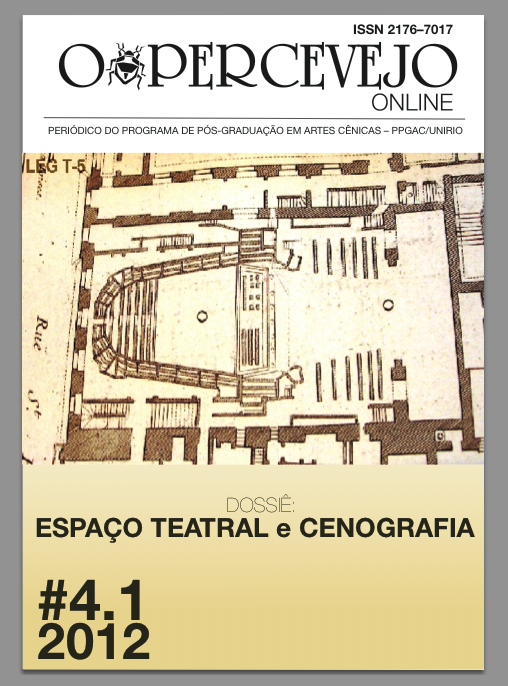“O Teatro efêmero Serliano e o edifício teatral renascentista”
DOI:
https://doi.org/10.9789/2176-7017.2012.v4i1.%25pResumo
Resumo O presente estudo evidencia alguns termos que compõem o lugar das ‘artes cênicas’ relacionadas à arquitetura na primeira metade do século XVI italiano e seu desdobramento posterior. Para tanto, optou-se por um exame mais atento acerca da terminologia vigente na tratadística renascentista, na qual se insere o Da Arquitetura e Perspectiva (1537) de Sebastiano Serlio, importante fonte primária que reúne por viés da arquitetura, matérias da pintura, escultura, relevo e teatro. Mesmo dirigindo-se aos arquitetos, o assunto principal que permeia o livro em questão é a perspectiva exata pensada por meio de uma visão de arquitetura que surge de uma construção geométrica e estende-se para uma construção visual. Do mesmo modo, a perspectiva exata, denominada scenografi a, é apresentada como um recurso técnico que serve à arquitetura, ora também relacionada à óptica (ópsis), pela prescrição da pintura. Palavras –chave | arquitetura | prática cênica | Serlio Abstract The current study highlights some terms that make the “place of the arts” related to architecture, in the first half of the Italian sixteenth century and its later deployment. To this end, it is opted for a closer look on the existing terminology in Renaissance treatises, in which is inserted the On Architecture and Perspective (1537) by Sebastiano Serlio, important primary source that brings together, through architecture, subject matters of painting, sculpture, relief and theater. Even though addressing to the architects, the main issue of the book is the exact perspective, thought from an architectural vision that arises from a geometric construction and extends to a visual one. Similarly, the exact perspective, called scenography is presented as a technical resource that serves architecture, sometimes also related to the optical (opsis), through painting prescription. Key-words | Architecture | scene practice | Serlio Vania Cristina Cerri é Doutora em Arquitetura (cenografia teatral) pela FAU–USP e mestre em Filosofia pela FFLCH-USP, tem como objeto de estudo a Estética e a Cenografia Teatral no Renascimento. Especialista em Arte e Educação pela ECA-USP. Graduada em Educação Artística com habilitação em desenho. É professora na Pós-graduação e na Graduação da Universidade Anhembi Morumbi nas disciplinas de Vitrinismo e Cenografia. É pesquisadora do Laboratório de Tridimensionalidade da FAU-USP, sob orientação do prof. Dr. Mário Henrique D'Agostino, desenvolvendo modelos tridimensionais do teatro vitruviano.Tem formação como cenógrafa e figurinista pela USP e pelo Teatro Colón de Buenos Aires. Vania Cristina Cerri holds a PhD in Architecture (theatrical scenography) from FAU-USP and a Master degree in philosophy from FFLCH-USP. She studies the aesthetics and the theatrical scenography in the Renaissance. She is an Art and education specialist from ECA-USP and teaches at Universidade Anhembi Morumbi. She is a researcher at the Laboratory of Three-dimensionality of FAU-USP, under the coordination of Prof. Dr. Mário Henrique D'Agostino, developing three-dimensional models of the Vitruvian theatre. She has as a set and costume designer degree from the University of São Paulo and the Teatro Colon in Buenos Aires. Integra em PDFDownloads
Não há dados estatísticos.
Downloads
Publicado
2012-11-01
Como Citar
Cerri, V. C. (2012). “O Teatro efêmero Serliano e o edifício teatral renascentista”. O Percevejo Online, 4(1). https://doi.org/10.9789/2176-7017.2012.v4i1.%p
Edição
Seção
Do espaço teatral


